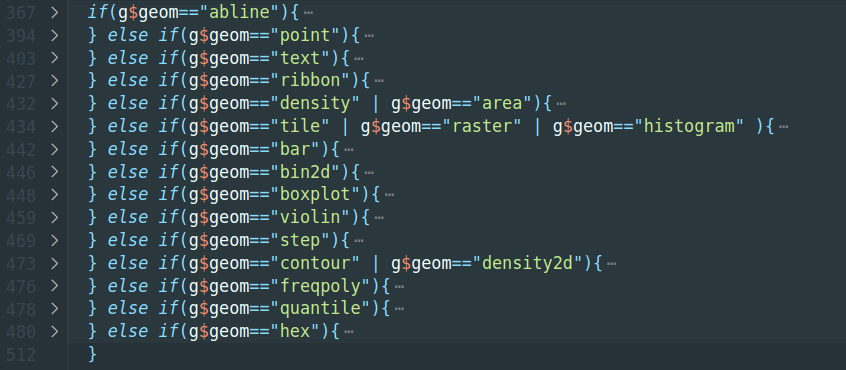Hi, I’m Himanshu Singh(@lazycipher). In this post, I’ll be sharing things that I’ve been doing from August 1, 2020 - August 24, 2020 i.e the third coding period.
What I did during the 3rd coding period?
In the last coding period, I had to move geom specific calculation to geom specific class definitions. Earlier the sqquence was that when you invoke animint2dir(), it used to call savelayer() for each layer and saveLayer() used to calculate all the needed data for animint2. In this approach, we had to check geom$ type of each and every layer and then calculate needed data for them and move ahead. This caused a big if(){} else{} block which made the maintainability readability of code.

We had to get rid of this block by using OOPs concept. In order to solve this, we created a pre_process() method in the base Geom class. Now we moved all the geom specific code which was responsible for geom specific pre processing/calculations to the pre_process() method of those specific geom class definitions.
This allowed us to execute specific code by just calling GeomClass$pre_process().
For example, let’s see how we moved calculation of geom abline. The class GeomAbline, we’ve a new method called pre_process() which can be accessed by GeomAbline$pre_process(...).
pre_process = function(g, g.data, ranges) {
for(i in 1:nrow(g.data)) {
g.data[i, "x"] <- ranges[[ g.data$PANEL[i] ]]$x.range[1]
g.data[i, "xend"] <- ranges[[ g.data$PANEL[i] ]]$x.range[2]
g.data[i, "y"] <- g.data$slope[i] * g.data$x[i] + g.data$intercept[i]
g.data[i, "yend"] <- g.data$slope[i] * g.data$xend[i] + g.data$intercept[i]
if(g.data$y[i] < ranges[[ g.data$PANEL[i] ]]$y.range[1] ) {
g.data$y[i] <- ranges[[ g.data$PANEL[i] ]]$y.range[1]
g.data$x[i] <- (g.data$y[i] - g.data$intercept[i]) / g.data$slope[i]
}
if(g.data$yend[i] > ranges[[ g.data$PANEL[i] ]]$y.range[2]) {
g.data$yend[i] <- ranges[[ g.data$PANEL[i] ]]$y.range[2]
g.data$xend[i] <- (g.data$yend[i] - g.data$intercept[i]) / g.data$slope[i]
}
}
g$aes <- g$aes[names(g$aes)!="group"]
g.data <- g.data[! names(g.data) %in% c("slope", "intercept")]
g$geom <- "segment"
return(list(g = g, g.data = g.data))
}
After the current implementation, the if else block is now replaced with the following code:
processed_values <- l$geom$pre_process(g, g.data, ranges)
g <- processed_values$g
g.data <- processed_values$g.data
It really improved the redability and it’ll help in maintaining the code in future.
The second change was moving the code which was responsible for common pre processing/calculations to a new method export_animint() which invokes the pre_processing(). Now the saveLayer() function is replaced with export_animint(). Which is now being called inside animint2dir() using Geom$export_animint(...).
At the end, I updated the needed documentation so that animint2 can again be deployed on cran.
After this, the PR was merged to master branch and now it’s submitted to CRAN so that it can be made available for everyone.
Any unsolved issue?
The implementation of new aesthetics to work with selected data is in progress as of now.
Anything I messed up?
Yes, Initially I was having issues in figuring out how do I implement this using OOPs but later on with the help of Mr. Toby, we figured it out, implemented and solved this issue.
 lazycipher
lazycipher 
 Coding Period Report 2 (July 1, 2020 - July 30, 2020)
Coding Period Report 2 (July 1, 2020 - July 30, 2020)